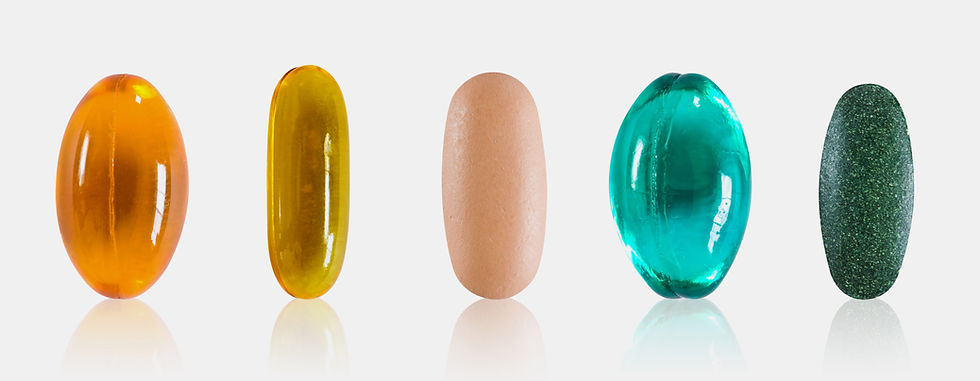All about Seed Cycling
- Hayley Vetras

- Aug 7, 2019
- 4 min read
Updated: Aug 12, 2019

We've talked about the gut, the liver and environmental toxins, about anxiety and stress, and most recently about sleep. All of these things can throw your hormones out of whack. For women, hormonal imbalance is the root of many health issues like irregular periods, acne, PCOS (which can result in excess hair growth/loss and weight gain), low libido, thyroid disorders, mood swings, and chronic fatigue. We've learned how diet and lifestyle changes can help alleviate these symptoms and seed cycling is another way to do that.
I've heard a little about seed cycling, what is it exactly?
Seed cycling is a process that involves rotating certain types of seeds (pumpkin, flax, sunflower, and sesame seeds) throughout the four phases of your menstrual cycle (menstruation, the follicular phase, ovulation and the luteal phase). The purpose of seed cycling is to balance your estrogen and progesterone levels at the right times. When this happens, estrogen levels should rise during the first half of the menstrual cycle and progesterone levels should rise during the second half. Having the right balance helps make cycles more regular, can lessen PMS symptoms, and combat all the different hormonal imbalances listed above. It has even been said to help people get their period back if it's been MIA for a while and help with fertility.
Interesting, so how does it work?
On days 1-14 of your cycle (day one being the first day of your period) consume the following:
1 tbsp daily of raw, organic, ground flax seeds daily
Flax seeds: contain special properties called lignans which can help to bind excess estrogen so that you can avoid estrogen dominance. It also helps lengthen the luteal phase (the fourth phase of your menstrual cycle) which improves ovulation and elevates PMS symptoms like breast tenderness and cramps.
1 tbsp daily of raw, organic, pumpkin seeds daily
Pumpkin seeds: High in the trace mineral (a mineral that your body needs by only in small amounts) zinc, support progesterone production and release for the second phase of the cycle.
Days 1-14 are your menstruation and follicular phases. Note, that women's cycle lengths are all different so this is just an estimate. If you are on birth control, you are not getting a real period so you will start this process when there is a new moon and follow accordingly. Just like the menstrual cycle, the moon cycle has four major phases (new moon, waxing, full, waning) so it is easy to track with the moon. Ground flax seeds and raw pumpkin seeds support both estrogen production and metabolism. They are rich in omega-3 fatty acids which promote enhanced uterine blood flow and maintain healthy cell membranes. They are a great way to create balanced estrogen, which is key during the follicular phase.
Another way to help support the menstruation and follicular phases is by increasing your Omega-3 intake. If you are not getting enough through food, you can add an extra boost by taking Fish or Cod Liver Oil (2000-3000 mg DHA/EPA).
And what about the second half of my cycle?
On days 15 - 28 of your cycle consume the following:
1 tbsp of raw, organic sunflower seeds daily
Sunflower seeds: High in the trace mineral selenium which assists in the detoxification process of hormones in the liver where estrogen is released. Also high in Vitamin E which can increase the production of progesterone.
1 tbsp of raw, organic sesame seeds daily
Sesame seeds: Also contain lignans that help to block excess estrogen. It also contains zinc which can help the formation of the corpus luteum which produces progesterone and stimulates the uterus to thicken in preparation for potential implantation.
Days 15 - 28 are typically your ovulation and luteal phases although again it will vary so you can switch to these seeds whenever you start the ovulation phase (or when there is a full moon) until you get your period (or the new moon). Sunflower and sesame seeds support progesterone levels, which is the key hormone during the luteal phase.
For an additional supplement boost to help with the ovulation and luteal phases, you can take Evening Primrose Oil (500 mg GLA) & Fish Oil (1000 mg).
So do I really need to consume seeds on a daily basis?
As with all things related to nutrition, I believe in moderation and sustainability. I don't seed cycle religiously, but I am mindful of it and become more consistent when I notice more hormonal imbalances. If you have an allergy or sensitivity to one of these seeds you should avoid it and double the dosage of the ones you can have. All in all, these are good foods to be incorporating into your diet even if you don't have a hormonal imbalance, so let's talk about ways you can do that.
Easy ways to get these in your diet:
Blend into smoothies or add as a topping to a smoothie bowl
Sprinkle on top of chia seed pudding
Mix into salad dressings
Create your own seed butter
Add to oatmeal
Or my favorite - seed cycling bites
It can take up to three months to see the benefits of seed cycling so I would recommend taking note of any changes in a journal or an app like MyFlo. Seed cycling works best when doing it in conjunction with other hormone balancing foods and lifestyle changes. Check out the previous articles I listed at the beginning of this blog or here. Do you think you have a hormonal imbalance? Take this quiz to find out & sign up for a free 30 minute nutrition assessment.





Comments